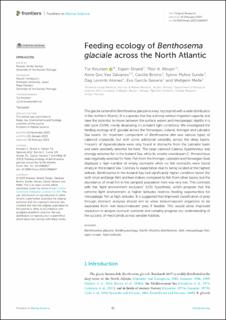Feeding ecology of Benthosema glaciale across the North Atlantic
Knutsen, Tor; Strand, Espen; Klevjer, Thor A.; Salvanes, Anne Gro Vea; Broms, Cecilie; Sunde, Synne Myhre; Aksnes, Dag Lorents; García-Seoane, Eva; Melle, Webjørn Raunsgård
Peer reviewed, Journal article
Published version
Permanent lenke
https://hdl.handle.net/11250/3074302Utgivelsesdato
2023Metadata
Vis full innførselSamlinger
- Articles [3016]
- Publikasjoner fra CRIStin [3074]
Sammendrag
The glacier lanternfish Benthosema glaciale is a key myctophid with a wide distribution in the northern Atlantic. It is a species that has a strong vertical migration capacity and have the potential to move between the surface waters and mesopelagic depths in a diel cycle (DVM), mainly depending on ambient light conditions. We investigated the feeding ecology of B. glaciale across the Norwegian, Iceland, Irminger and Labrador Sea basins. An important component of Benthosema diet was various types of calanoid copepods, but with some additional variability across the deep basins. ‘House’s’ of Appendicularia were only found in stomachs from the Labrador basin and were positively selected for here. The large calanoid Calanus hyperboreus was strongly selected for in the Iceland Sea, while its smaller counterpart C. finmarchicus was negatively selected for here. Fish from the Irminger, Labrador and Norwegian Seas displayed a high number of empty stomachs while no fish stomachs were found empty in the Iceland Sea. Contrary to expectation due to being located at the highest latitude, Benthosema in the Iceland Sea had significantly higher condition factor (for both small and large fish) and liver indices compared to fish from other basins, but the abundance of small fish in the sampled population here was very low. This contrasts with the “light environment exclusion” (LEE) hypothesis, which propose that the extreme light environment at higher latitudes restricts feeding opportunities for mesopelagic fish at high latitudes. It is suggested that improved classification of prey through stomach analyses should aim to allow bioluminescent organisms to be separated from non-bioluminescent prey if feasible. This would allow improved resolution to analyse stomach contents and certainly progress our understanding of the success of myctophids across variable habitats.
